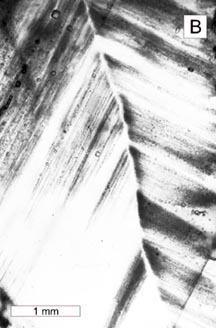

Glimpsing ancient oceans
Ancient droplets of seawater trapped inside halite crystals are helping prove that ocean chemistry over the past 544 million years was often different from ocean chemistry today.
Today's ocean is magnesium-rich, but in 1996, one maverick scientist suggested that the ocean flips between being magnesium-rich and magnesium-poor every 100 to 200 million years. Initially, this theory, proposed by Lawrence Hardie at Johns Hopkins University in Baltimore, Md., met with widespread skepticism. Most ocean chemists maintained the widely held belief that the type and amount of ions, like magnesium, in seawater have remained constant.
Now, Tim Lowenstein and his colleagues, all at State University of New
York in Binghamton, N.Y., working in collaboration with Hardie, claim they
have concrete evidence of seawater chemistry change. They examined tiny
droplets of water, smaller than the thickness of a human hair, that were
trapped inside ancient halite crystals during crystal formation. The halite
crystals represented multiple geologic time periods from such disparate
locations as Australia, the United States, Brazil, the Congo and Thailand.
To measure the chemistry of the seawater in these time capsules without contaminating the water, the scientists froze the halites and then pointed an electron beam onto the frozen water inside. This beam helps decipher the proportions of various ions present in the seawater.
Tiny droplets of ancient seawater are trapped within the thin dark lines on this halite crystal, which formed during the Permian. The "bubbles" also contain trapped seawater. Photo courtesy of Tim Lowenstein.
The results, published today in Science, showed big differences in past ocean chemistry composition for six different time periods. "Some analyses showed that ancient seawater was pretty close to modern seawater," Lowenstein says. "But there's another group that's quite different from today's seawater."
In particular, the data reveal magnesium-poor oceans in the Cambrian, Silurian and Cretaceous, and magnesium-rich oceans in the late Precambrian, Permian and Tertiary. The swinging back and forth of the data between magnesium-poor and rich seawater coincides with other patterns in Earth's history.
The mineral composition of marine deposits, including evaporite rocks and small sand grains called ooids, match the fluctuations in seawater chemistry. The seesaw also mirrors long-term changes in global climate and sea levels. Even microscopic organisms that use seawater minerals to build body armor appear to have flourished in some periods and receded in others, in keeping with changing seawater chemistry. During the Cretaceous, for example, coccolithophore algae thrived and when they died or shed their armor it accumulated as geologic formations, including the White Cliffs of Dover in England.
Some scientists who were initially unsure of Hardie's changing seawater chemistry theory are beginning to accept it. "We were very skeptical for a long time," says Dick Holland of Harvard University, "but we've come around and think that what he proposed is roughly right."
Holland still has some concerns. He points out that the trapped water isn't pure ancient seawater. Rather, an evaporation process concentrated the water during its entrapment and models must be used to predict the actual past chemistry. Holland thinks the next step is to find pure ancient seawater, which he believes exists in carbonate cements, albeit in small amounts that will be difficult to measure.
Also, the question remains as to what regulates the chemistry of seawater. Hardie suggested that seawater chemistry depends on varying amounts of river water and mid-ocean ridge hydrothermal vent brines entering the ocean and mixing together. Holland thinks this explanation is too simplistic.
Nonetheless, now that more scientists are warming up to the idea of changing ocean chemistry, science can pursue how this, in turn, affected life, Lowenstein says. "The really exciting thing now is for paleontologists to look at fossils and see how seawater chemistry has influenced the evolution of organisms," he says.
Rowena Rae
Geotimes contributing writer
Web links of interest:
What is Coccolithophore algae?
 |
Geotimes Home | AGI Home | Information Services | Geoscience Education | Public Policy | Programs | Publications | Careers |